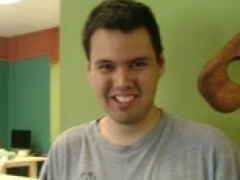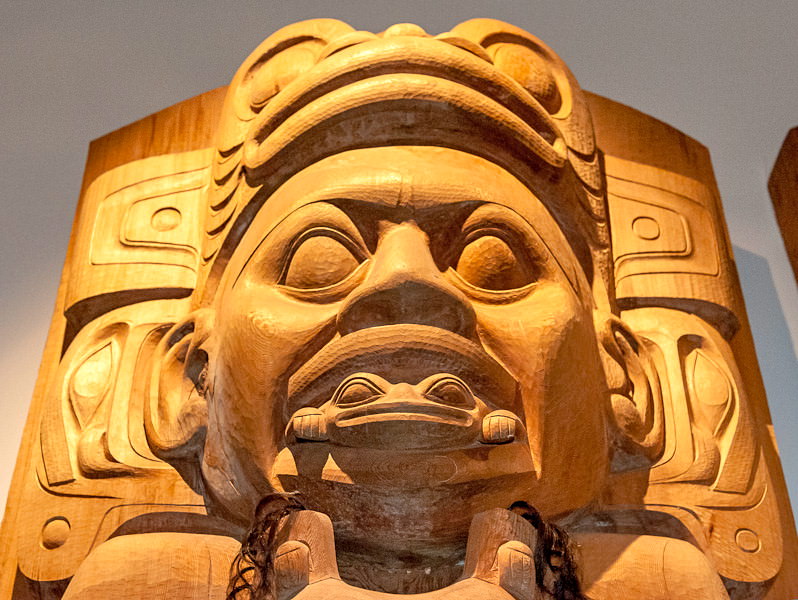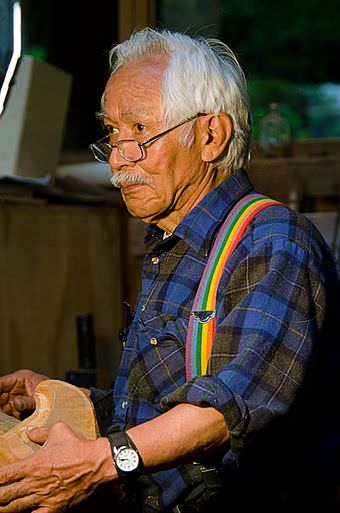WAYNE G. PRICE, Tlingit Master Carver
Native Alaskan artist Wayne G. Price creates master-quality fine art in the traditional Northwest Coast style of the Tlingit Indian tribe. Using exceptional skills in design and carving, Price creates art that covers a broad range of traditional artifacts, including totem poles, canoes, masks, paddles, clan hats and jewelry. Price is held in high esteem for his mastery of traditional Tlingit design, providing original art for public indoor and outdoor spaces, Native corporations, private commissions and more. Northwest Coast form-line art is an intricate and complex style of totemic design, proportion and space, and Price is an elite grand master of this ancient art. Unrivalled in his adzing capabilities in the finishing process of his carvings, Wayne can duplicate patterns used by the old master carvers of his ancestors.
Price has carved 27 traditional totem poles and several non-traditional poles. One of his carvings in Juneau tells the story of the traditional land users, the Auk Kwan. In 2012, he designed and carved a 40-foot totem meant to inspire residential school healing. The 40-foot “Kooteeyaa,” designed and carved for SEARHC, an Alaska Native health facility, stands in the centre of headquarters campus in Sitka and tells the story of Native Wellness. The 25-foot totem “Our Grandchildren’s House” was created in 2008 for Thunder Mountain High School in Juneau. A story of nurturing the youth of today and tomorrow through education and culture, the pole stands in a prominent position for greeting the public, in the school’s commons area.
Price is the owner and art director of Silver Cloud Art Center in Haines, Alaska, and a fire-starter with White Bison (www.whitebison.org), the Red Road to Wellbriety Training Institute. Silver Cloud promotes a sobriety lifestyle using tools of Native culture, art, ceremony and community. Price’s way of life is strongly connected to his Tlingit ancestors’ tribal values. He is committed to ensuring the preservation of Tlingit art, culture and traditions.
NATHAN JACKSON, Tlingit Master Carver
Nathan Jackson, born August 29, 1938, is among the most important living Tlingit artists and Alaskan artists. Best known for his totem poles, he works in a variety of media.
Jackson belongs to the Sockeye clan on the Raven side of the Chilkoot Tlingit. As a young adult, he served in the military in Germany and then became involved in commercial fishing. While ill with pneumonia and unable to fish, he began to carve miniature totem poles. His interest in art was piqued, and he enrolled in the Institute of American Indian Arts in Santa Fe, New Mexico. Since then, he has carved large totem poles, canoes, doors, wood panel clan crests, masks and jewelry. Jackson has worked to pass on traditional Tlingit carving skills to younger artists, and has offered many demonstrations and workshops throughout Alaska and the Pacific Northwest.
Jackson has created more than 50 totem poles, some of which are on display in the National Museum of the American Indian, the Field Museum in Chicago, Harvard University’s Peabody Museum and other museums in the United States, Japan and Europe. He is the recipient of a National Endowment for the Arts National Heritage Fellowship (1995), a Rasmuson Foundation Distinguished Artist Award (2009) and an honorary doctorate in humanities from the University of Alaska, Southeast.
Jackson currently resides in Ketchikan, Alaska. His wife and son are also artists.
ROBERT DAVIDSON, Haida Master Carver
Robert Davidson, one of Canada’s most respected and important contemporary visual artists, is a Northwest Coast Native of Haida and Tlingit descent. A master carver of totem poles and masks, he works in a variety of other media as a printmaker, painter and jeweller. He is well known as an impeccable craftsman whose creative and personal interpretation of traditional Haida form is unparalleled. His distinctive style is appreciated by the Haida Community and contemporary art scholars alike, with many of his works considered post-modern masterpieces. His work is sought by collectors internationally.
Robert Davidson is a leading figure in the renaissance of Haida art and culture and a founding member, with his brother, Reg Davidson, of the Rainbow Creek Dancers. He is also one of the founding members of the Haida Gwaii Singers Society, started by Terri-Lynn Williams-Davidson. http://www.robertdavidson.ca
DAVID BOXLEY Sr. and Jr.,
Tsimshian Master Carvers & Performers
 David Boxley is the first Alaskan Tsimshian to achieve national prominence. He is particularly well respected as a totem pole carver, having carved 65 in the last 26 years. He has taught and demonstrated at some of the most important museums worldwide.
David Boxley is the first Alaskan Tsimshian to achieve national prominence. He is particularly well respected as a totem pole carver, having carved 65 in the last 26 years. He has taught and demonstrated at some of the most important museums worldwide.
In all of David Boxley’ s works of art, from totem poles to prints, he emphasizes Tsimshian style. In the recent resurgence of Native American cultural traditions, artists have become the culture bearers for their tribes. Boxley accepts this responsibility not only by his creating his carvings, but by bringing the traditions he has learned back to his home village.
Boxley has been deeply involved in the rebirth of Tsimshian culture through organizing and hosting potlatches in Alaska and Washington. In 1996, he was responsible for the first Seattle Northwest Coast potlatch in 100 years. He also reintroduced the potlatch to his home village of Metlakatla, Alaska. These events involve traditional cultural activities such as clan adoption, name giving, gift giving, ceremonial regalia dedication and memorials, as well as singing and dancing.
“Artists from long ago inspire new generations of Indians to carry on the traditions of which they began. I am determined and dedicated to become the finest artist that I can be, while at the same time helping to revitalize and carry on the rich culture of my tribe: I want my sons and other young Indian people to be proud of their heritage.” http://wwww.davidboxley.com
JOE DAVID, Nuu-Chah-Nulth Master Carver
Joe David was born in 1946 at Opitsaht, a Clayoquot village on Meares Island, on the western shore of Vancouver Island. The family resettled in Seattle in 1958 and moved frequently during his teen years. His father, Hyacinth David, was a respected chief and elder of the Clayoquot nation. Even though he removed his family from Nuu-Chah-Nulth territory, he remained connected to the village and practiced its traditional values and ceremonies. Joe vividly recalls watching the ceremonies he attended as a child. His grandmother was a medicine-woman who predicted that Joe would become an artist while he was still an infant. Both his father and mother had been initiated in the (Klukwana) Wolf ritual. In 1969, he received from his father’s family the name “Ka-Ka-Win- Chealth” (Supernatural White Wolf transforming into Killerwhale), in recognition of his commitment to carving and cultural participation. Joe expanded the cultural teachings started by his father by visiting museums and libraries and studying Nuu-chah-nulth art and culture.
He studied art in Seattle and San Marcos, Texas, but his interest in his own heritage and tradition led him to Bill Holm, the Northwest Coast scholar at the University of Washington, to begin an intensive study of traditional Northwest Coast objects. His later investigations concentrated on only Nuu-chah-nulth style.
In 1988, he participated in the Sundance ceremonies and he has continued to attended each year—and, with rare exception, has often been one of the participants. Today, Joe David is among the most respected master artists of the Northwest Coast. Museums, private collectors, and corporations collect his graphics, wood sculpture, silver, and bronze internationally. He is also dedicated to participating and contributing to contemporary ceremonies, as well as lecturing on Northwest Coast art.
TRESHAM GREGG, Multi-disciplinary Artist
“I like to call myself a multi-medium mystic or fantasy artist. I work in a number of mediums. Woodcarving is my specialty, but I also work with silk screen printing, painting, metal sculpture, talismanic jewelry, puppet making and improv.
I started off carving when I was a teenager growing up in Fort Seward, Haines, Alaska, as a member of a Boy Scout troop, learning about Native art and culture, creating regalia, and performing masked dance theater shows of Native Legends–making the connection between the wild animals of the land, sea and sky, and the spirit realm, where animals take on human characteristics with a supernatural perspective. This experience inherently became part of who I am as an artist. I like to reveal and animate natural phenomena as spirit forces, like the Northern Lights being Eagles or Ravens or Aurora Dancers. I get there through impressionist treatments in various mediums–somewhat abstract, somewhat stylized, somewhat fantasy treatments of form and flow. Dance is the basic element in my work as it is a connection to a subconscious guiding hand.
My spiritual philosophy is a mixture of Northwest Coast Native spiritual thinking and Hindu mythology. I am also an artistic adventurer, travelling to various places in the world to explore the art of different cultures and have unique artistic involvement with local peoples. Recently I did a masked-dance theater show in Panajachel, Guatemala, with local young Mayan people called “Return of the Jaguar.” Currently, I am fascinated with the world of puppetry. It is a great connection to different perspectives, humor and storytelling. Everything is hand made by me and my assistants mostly in my studios in Haines, Alaska.” http://www.tresham.com
OWEN MUNROE, Wood Sculpture, Whitehorse, Yukon Territory, Canada







